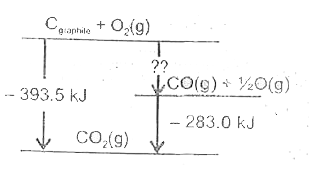The values of and for the reaction,
are and respectively. This reaction will be spontaneous at
A
510 K
B
170K
C
910K
D
1110K
Video Solution
Text Solution
The correct Answer is:D
For a spontaneous reaction
Or ar eq.
|
Similar Questions
Knowledge Check
Consider the following reaction :
CO(g)+12O2(g)→CO2(g)
How are ΔU and ΔH related for the reaction ?A(a) ΔH=ΔU−0.5RTB(b) ΔH=ΔU−RTC(c) ΔH=ΔU+0.5RTD(d) ΔH=ΔU−1.5RTThe value of enthalpy change (ΔH) for the reaction
C2H5OH(l)+3O2(g)→2CO2(g)+3H2O(l)
at 27∘C is −1366.5kJmol−1. The value of internal energy change for the above reaction at this temperature will beA−1371.5kJB−1369.0kJC−1364.0kJD−1361.5kJ
Kp/Kc for the reaction
CO(g)+12O2(g)⇔CO2(g) is
View SolutionKp/Kc for the reaction
CO(g)+12O2(g)⇔CO2(g) is
View SolutionΔH and ΔS for
Br2(l)+CI2(g)→2BrCI(g)
are 29.00kJmol−1 and 100.0JK−1mol−1 respectively. Above what temperature will this reaction become spontaneous?
View SolutionA schematic representation of enthalpy changes for the reaction,Cgraphite+12O2(g)→CO(g) is given below. The missing value is

View SolutionFor the reaction
CO(g)+12O2(g)⇔CO2(g),Kp/Kc is
View SolutionFor hypothetical reversible reaction
1/2A2(g)+3/2B2(g)→AB3(g),ΔH=−20kJ if standard entropies of A2,B2, and AB3 are 60,40 and 50JK−1mol−1 respectively. The above reaction will be equilibrium at
View Solution
